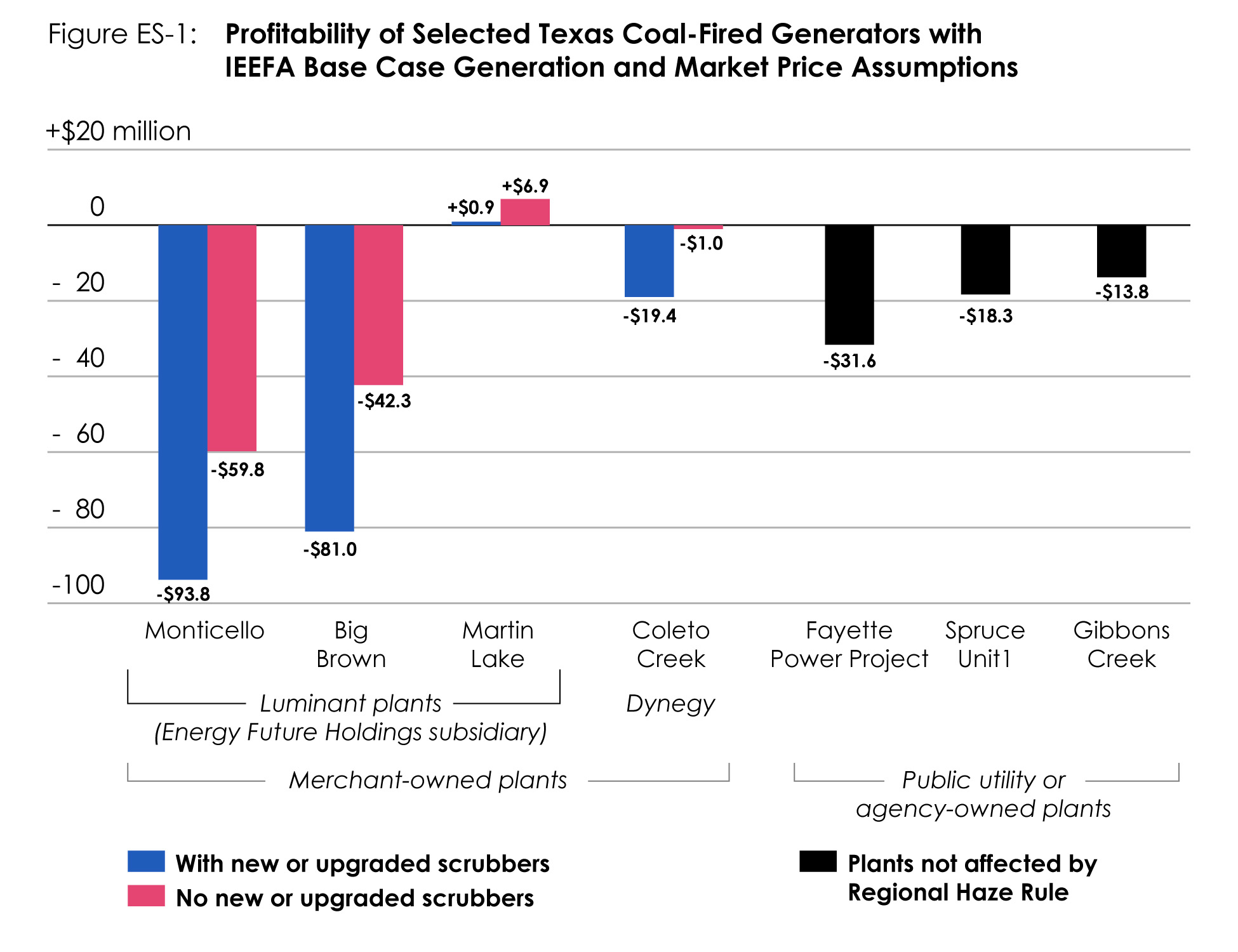The Institute for Energy Economics and Financial Analysis (IEEFA) released a study today that examines the finances of seven large Texas coal plants. The news isn’t good for the owners of those plants, but it’s great for those of us fighting keep climate change to a manageable level, clean up air pollution and preserve our water resources. The report – “The Beginning of the End: Fundamental Changes in Energy Markets Are Undermining the Financial Viability of Coal-Fired Power Plants in Texas” – describes how the coal-fired electricity industry in Texas is in decline and unlikely to recover in the face of rising competition from other energy sources.
The report, presented by IEEFA in partnership with Public Citizen, analyses the performance of four merchant generators—the Big Brown, Martin Lake and Monticello plants owned by EFH’s Luminant subsidiary, and the Coleto Creek plant owned by Dynegy. It also analyzes three coal-fired plants owned public power utilities or power agencies—the Fayette Power Project (co-owned by Austin Energy and the Lower Colorado River Authority), Gibbons Creek (currently up for sale by the Texas Municipal Power Agency), and J.K. Spruce Unit 1 (owned by San Antonio’s CPS). The 8,100 MW of capacity from these seven plants represents a little more than 40 percent of the total coal-fired capacity in ERCOT.
The study shows that all but one of the plant is losing money and that even that one – Martin Lake – is barely making a profit. If output or market prices dip below those assumed in the base case scenario, Martin Lake will also lose money – and all of the other plants will lose even more than they already are.
 “None of the units is financially viable, as none can be expected to produce substantial pre-tax earnings for their owners or be economic for ratepayers in coming years. Indeed, all but one of the plants can be expected to produce pre-tax losses for their owners in coming years,” report author David Schlissel summarized.
“None of the units is financially viable, as none can be expected to produce substantial pre-tax earnings for their owners or be economic for ratepayers in coming years. Indeed, all but one of the plants can be expected to produce pre-tax losses for their owners in coming years,” report author David Schlissel summarized.
“The key finding is that fundamental economic transformations are undermining coal plants in Texas and that six of seven Texas coal-fired generators they studied in Texas are at risk of retirement,” said Tom “Smitty” Smith, director of the Texas office of Public Citizen. “The coal industry is undergoing rapid changes in Texas as EFH resolves its bankruptcy and considers retirement of its oldest plants, as Gibbons Creek is being sold, as Austin Energy has begun to put money toward the retirement of its Fayette plant, as CPS retires rather than retrofit its JT Deeley coal plant,” Smith said. “We think other Texas utilities should follow their lead. The transition will reduce costs, clear the air and create jobs.”
The report notes several forces arrayed against coal-fired generation and that suggest retirement of coal-fired plants is likely:
- The collapse of natural gas prices and subsequent declines in the cost of generating power and the increases in generation at natural gas-fired power plants.
- Increased competition from thousands of megawatts (MW) of new wind and solar resources due to steep declines in installation prices, improved operating efficiencies and transmission upgrades.
- Low energy market prices in ERCOT’s deregulated wholesale markets driven by lower natural gas prices and increased generation from renewable resources. (Unlike in some regions of the country, ERCOT does not have a “capacity” market, which often serves to subsidize older plants and keep them on-line when they are no longer cost competitive.)
- Sharp reductions in generation from coal-fired plants as their output has been displaced by increased output from renewable and natural gas-fired capacity. Many coal-fired power plants in Texas no longer act as “baseload plants,” and are instead limited to operations during the peak load seasons. Although coal-fired plants generated 39 percent of the electricity in ERCOT in 2015, by May of 2016 they provided only 24.8 percent.
- Public health and environmental regulations, including the EPA’s regional haze rule, that are forcing coal-fired power plant owners to decide whether to make expensive investments in their aging coal fleet.
Schissel said it is not a question of whether ERCOT reliance on coal will fade, but when. “The discussion should shift now to how to phase out these plants, what to replace them with, and how to retrain their workers.”


